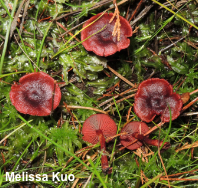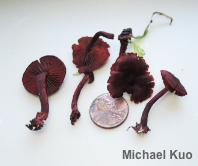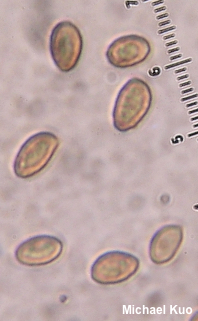| Major Groups > Gilled Mushrooms > Dark-Spored > Cortinarius > Cortinarius sanguineus |

|
Cortinarius sanguineus [Basidiomycota > Agaricales > Cortinariaceae > Cortinarius ... ] by Michael Kuo First described from Europe in the 18th Century, Cortinarius sanguineus can be recognized by its bright red colors (the cap, gills, and stem are all bright red), its smallish size, and its association with northern or montane conifers. In North America it appears in the northeastern United States and Canada, where it can be recognized by the more or less the same characters that distinguish it in Europe. However, there are several sanguineus-like species in North America, so identifying little red species of Cortinarius on our continent requires careful attention: In western North America, the Sierra Nevada's Cortinarius sierraensis has orangish red colors, while the Pacific Coast's Cortinarius neosanguineus is red to purplish red. Additionally, the West Coast's Cortinarius smithii is similar but features a contrasting yellow stem. In eastern North America, look-alikes for Cortinarius sanguineus include Cortinarius marylandensis, which grows under hardwoods rather than conifers and features pink basal mycelium—and Cortinarius harrisonii, appearing under hardwoods or conifers but separable because of its yellow basal mycelium and its Appalachian (rather than northern Appalachian and boreal) distribution. Description: Ecology: Mycorrhizal with conifers—primarily spruces but also with firs, eastern hemlock, and northern white-cedar; growing alone, scattered, or gregariously; summer and fall; originally described from Austria; fairly widely distributed in northern and montane Europe; in North America known from boreal and sub-boreal ecosystems from Michigan to Newfoundland and New Jersey. The illustrated and described collection is from New Jersey. Cap: 1.5–4.5 cm; convex or bell-shaped at first, becoming broadly bell-shaped, convex, or nearly flat; dry; silky to finely hairy; bright, dark red; the margin not lined. Gills: Broadly attached to the stem; close; colored like the cap, becoming cinnamon to rusty red; short-gills frequent; when young covered by a red cortina. Stem: 3–6 cm long; 2–4 mm thick; more or less equal; dry; silky; colored like the cap; sometimes with a rusty ring zone; basal mycelium reddish. Flesh: Whitish to pale pinkish; unchanging when sliced. Odor: Not distinctive. Spore Print: Rusty brown. Microscopic Features: Spores 6–8 x 3.5–5 µm; ellipsoid or subamygdaliform; finely to moderately verrucose. Basidia 15–20 x 5–6 µm; subclavate; 4-sterigmate. Pleurocystidia not found. Marginal cells 8–12 x 5–7 µm; clavate to obpyriform; smooth; thin-walled. Pileipellis a cutis; elements 10–15 µm wide, smooth, hyaline to pink-walled in KOH, clamped at septa. REFERENCES: (F. X. von Wulfen, 1781) S. F. Gray, 1821. (Smith, Smith & Weber, 1979; Phillips, 1980; Ammirati & Smith, 1984; Arora, 1986; Brandrud et al., 1990; Phillips, 1991; Lincoff, 1992; Liu et al., 1995; Liu et al., 1997; Barron, 1999; McNeil, 2006; Buczacki et al., 2013; Niskanen et al., 2013; Evenson, 2015; Gminder & Böhning, 2017; Niskanen et al., 2018; Læssøe & Petersen, 2019; Kibby, 2021.) Herb. Kuo 10101508. This site contains no information about the edibility or toxicity of mushrooms. |
© MushroomExpert.Com |
|
Cite this page as: Kuo, M. (2022, January). Cortinarius sanguineus. Retrieved from the MushroomExpert.Com Web site: http://www.mushroomexpert.com/cortinarius_sanguineus.html |


